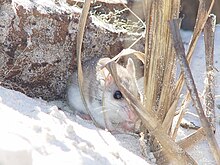| Oldfield mouse | |
|---|---|

| |
| Oldfield mouse at the beach, Alabama | |
| Conservation status | |
 Least Concern (IUCN 3.1) | |
| Scientific classification | |
| Domain: | Eukaryota |
| Kingdom: | Animalia |
| Phylum: | Chordata |
| Class: | Mammalia |
| Order: | Rodentia |
| Family: | Cricetidae |
| Subfamily: | Neotominae |
| Genus: | Peromyscus |
| Species: | P. polionotus |
| Binomial name | |
| Peromyscus polionotus (Wagner, 1843) | |

| |
| native range | |
| Synonyms | |
List
| |
The oldfield mouse, oldfield deermouse or beach mouse (Peromyscus polionotus) is a nocturnal species of rodent in the family Cricetidae that primarily eats seeds. It lives in holes throughout the Southeastern United States in beaches and sandy fields. Predators to these mice include birds and mammals. In 2016, these mice were in the least concern category on the IUCN Red List with certain subspecies classified as extinct, critically endangered, endangered or near threatened.
Distribution and habitat
The oldfield mouse occurs only in the southeastern United States, ranging from Florida to Tennessee. They primarily live in beaches and sandy fields.
Description
The mouse has fawn-colored upperparts and grey to white underparts through most of its range, but on white sandy beaches, the mouse is light or even white. Inland populations are darker and smaller with shorter tails that are dusky above and white below. General body and tail color may vary slightly depending upon geographical location.
| Measurements (20 adults from Alabama, Florida, and Georgia) | |
|---|---|
| Length | 127 mm (5.0 in) 122–138 mm (4.8–5.4 in) |
| Tail | 47 mm (1.9 in) 40–51 mm (1.6–2.0 in) |
| Hind foot | 16.5 mm (0.65 in) 15–18 mm (0.59–0.71 in) |
| Weight | 8–19 g (0.28–0.67 oz) |
| Diploid number | 48 |
| Tooth formula | 1.0.0.31.0.0.3 = 16 |
Behavior
The mouse is primarily nocturnal.
Diet
P. polionotus is omnivorous and the principal diet is seasonal seeds of wild grasses and forbs, but blackberries, acorns, and wild peas may be consumed.
Shelter
These mice dig holes in earth to create homes. Spiders, snakes, and other animals may move into a burrow.
Reproduction
| Reproduction | |
|---|---|
| Sexual maturity (female) | 30 days |
| Gestation | 23–24 days |
| Litter size | 3–4 (viviparous) |
| Weight at birth | 1.1–2.2 g (0.039–0.078 oz) |
| Weaning | 20–25 days |
| Adult weight | 8–10 g (0.28–0.35 oz) |
Survival
Birds and mammals prey upon the oldfield mouse. Various types of parasites can effect oldfield mice, with nematodes being the main ones. One mouse survived in captivity for 5.5 years.
Conservation
In 2010, the beach mouse was in the least concern category on the IUCN Red List. For the beach mouse's subspecies, out of sixteen known, one is extinct, one was listed critically endangered, four endangered and two near threatened.
Under the Endangered Species Act of 1973, the following beach mice are protected as endangered or threatened subspecies:
- Southeastern beach mouse (Peromyscus polionotus niveiventris) – Threatened
- Anastasia Island beach mouse (Peromyscus polionotus phasma) – Endangered
- Alabama beach mouse (Peromyscus polionotus ammobates) – Endangered
- Perdido Key beach mouse (Peromyscus polionotus trissyllepsis) – Endangered
- Choctawhatchee beach mouse (Peromyscus polionotus allophrys) – Endangered
- St. Andrew beach mouse (Peromyscus polionotus peninsularis) – Endangered
The pallid beach mouse (Peromyscus polionotus decoloratus) is presumed extinct. The Santa Rosa beach mouse (Peromyscus polionotus leucocephalus) is listed as critically imperiled by NatureServe.
References
- Footnotes
- ^ Cassola, F. (2017) . "Peromyscus polionotus". IUCN Red List of Threatened Species. 2016: e.T42654A115199876. doi:10.2305/IUCN.UK.2016-3.RLTS.T42654A22359556.en. Retrieved 24 April 2023.
- ^ "Peromyscus polionotus (Wagner, 1843)". Integrated Taxonomic Information System. Retrieved 24 April 2023.
- ^ Whitaker 1998, p. 308
- Whitaker 1998, p. 309
- Wooten
- Whitaker 1998, p. 308–9
- Whitaker 1998, p. 309–10
- Whitaker 1998, p. 310
- Peromyscus polionotus
- "Southeastern beach mouse (Peromyscus polionotus niveiventris)". Environmental Conservation Online System. U.S. Fish & Wildlife Service. Retrieved 24 April 2023.
- ^ 54 FR 20598
- "Anastasia Island beach mouse (Peromyscus polionotus phasma)". Environmental Conservation Online System. U.S. Fish & Wildlife Service. Retrieved 24 April 2023.
- "Alabama beach mouse (Peromyscus polionotus ammobates)". Environmental Conservation Online System. U.S. Fish & Wildlife Service. Retrieved 24 April 2023.
- ^ 50 FR 23872
- "Perdido Key beach mouse (Peromyscus polionotus trissyllepsis)". Environmental Conservation Online System. U.S. Fish & Wildlife Service. Retrieved 24 April 2023.
- "Choctawhatchee beach mouse (Peromyscus polionotus allophrys)". Environmental Conservation Online System. U.S. Fish & Wildlife Service. Retrieved 24 April 2023.
- "St. Andrew beach mouse (Peromyscus polionotus peninsularis)". Environmental Conservation Online System. U.S. Fish & Wildlife Service. Retrieved 24 April 2023.
- 63 FR 70053
- Foust, Desirae (2002). Demastes, Jim (ed.). "Peromyscus polionotus". Animal Diversity Web. Retrieved 24 April 2023.
- NatureServe (7 April 2023). "Peromyscus polionotus decoloratus". NatureServe Network Biodiversity Location Data accessed through NatureServe Explorer. Arlington, Virginia: NatureServe. Retrieved 24 April 2023.
- "Santa Rosa beach mouse (Peromyscus polionotus leucocephalus)". Environmental Conservation Online System. U.S. Fish & Wildlife Service. Retrieved 24 April 2023.
- NatureServe (7 April 2023). "Peromyscus polionotus leucocephalus". NatureServe Network Biodiversity Location Data accessed through NatureServe Explorer. Arlington, Virginia: NatureServe. Retrieved 24 April 2023.
- Works cited
- Peromyscus polionotus, Human Ageing Genomic Resources, retrieved February 10, 2010
- Whitaker, John O. Jr.; Hamilton, William J. Jr. (1998), Mammals of the Eastern United States (3 ed.), Ithaca, NY: Cornell University Press, ISBN 0-8014-3475-0
- Wooten, Michael C., Peromyscus polionotus: Oldfield mouse, Auburn University, SC, archived from the original on June 13, 2010, retrieved February 11, 2010
| Taxon identifiers | |
|---|---|
| Peromyscus polionotus |
|